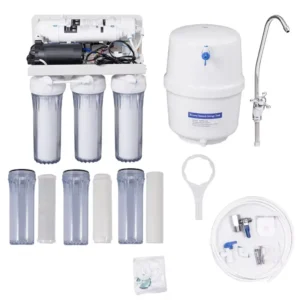How to Solve Short Filter Lifespan? Improve Water Quality
A common frustration for many water purifier owners is the seemingly short lifespan of their filters, which can lead to
frequent replacements and increased costs. However, the root cause of this issue is often poor water quality, and
addressing it can significantly extend the life of your filters.

addressing it can significantly extend the life of your filters.

Filters in water purifiers work by trapping contaminants such as sediment, chlorine, heavy metals, and bacteria. When
the water supply is heavily contaminated, these filters become clogged more quickly. For example, water with high levels
of sediment or turbidity will cause sediment filters to block up in weeks rather than months. Similarly, hard water, which is
rich in calcium and magnesium, can lead to limescale buildup on filter membranes, reducing their efficiency and lifespan.
the water supply is heavily contaminated, these filters become clogged more quickly. For example, water with high levels
of sediment or turbidity will cause sediment filters to block up in weeks rather than months. Similarly, hard water, which is
rich in calcium and magnesium, can lead to limescale buildup on filter membranes, reducing their efficiency and lifespan.
The first step in solving short filter lifespan is to identify the specific contaminants in your water. A water test kit can provide
valuable information about the levels of sediment, minerals, chlorine, and other impurities. Once you know what you’re
dealing with, you can take targeted action to improve water quality before it reaches the purifier.

valuable information about the levels of sediment, minerals, chlorine, and other impurities. Once you know what you’re
dealing with, you can take targeted action to improve water quality before it reaches the purifier.

One effective solution is to install a pre-filter. A pre-filter is a secondary filter that is placed before the main water purifier,
designed to catch larger particles such as sediment, sand, and rust. By removing these contaminants early, the pre-filter
designed to catch larger particles such as sediment, sand, and rust. By removing these contaminants early, the pre-filter
reduces the workload on the main filter, allowing it to last longer. Pre-filters are relatively inexpensive and easy to install,
making them a cost-effective investment.
For households with hard water, a water softener can be a game-changer. Water softeners remove calcium and magnesium
ions from the water, preventing limescale buildup in the purifier’s filters and other components. This not only extends filter life
ions from the water, preventing limescale buildup in the purifier’s filters and other components. This not only extends filter life
but also improves the overall efficiency of the purifier.
Water Purifier Factory, Water Purifier For Home, Water Purifier Machine,Water Purifier, Water Filter Purifier System
Water Purifier Factory, Water Purifier For Home, Water Purifier Machine,Water Purifier, Water Filter Purifier System
Regular maintenance of the water purifier is also crucial. Cleaning the filter housings regularly to remove any accumulated
debris can prevent clogs and ensure that water flows freely through the filter. Additionally, following the manufacturer’s
recommendations for filter replacement, even if the filter doesn’t appear completely clogged, can prevent overloading and
recommendations for filter replacement, even if the filter doesn’t appear completely clogged, can prevent overloading and
maintain optimal performance.
Another factor to consider is the flow rate of your water. High water pressure can force contaminants through the filter more
quickly, causing it to clog faster. Installing a pressure regulator can help maintain a steady, moderate flow rate, reducing strain on the filter.
quickly, causing it to clog faster. Installing a pressure regulator can help maintain a steady, moderate flow rate, reducing strain on the filter.
By taking steps to improve the quality of water entering your purifier, you can significantly extend the lifespan of your filters,
reduce replacement costs, and ensure that your purifier continues to provide clean, safe water for your family.
How to Solve Short Filter Lifespan? Improve Water Quality
reduce replacement costs, and ensure that your purifier continues to provide clean, safe water for your family.
How to Solve Short Filter Lifespan? Improve Water Quality

